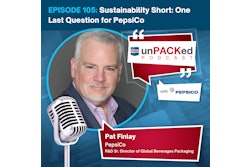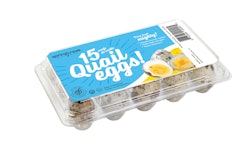Welcome to Sustainable Packaging. Explained your Guide to Sustainable Materials, methods, and package design, produced by the Emerging Brands Alliance in conjunction with Packaging World. In this episode, we're looking at package design and food, while sustainability can apply to agricultural practices, ingredient sourcing, and the processes of food manufacturing.
In this episode we’re looking at package design and food. While sustainability can apply to agricultural practices, ingredient sourcing, and the processes of food manufacturing, in this video we are going to focus on sustainability in food packaging. Packaging typically makes up less than 10% of the carbon footprint of a product, but if packaging fails, all manufacturing energy and efforts are wasted.
In a broad sense, sustainable packaging will protect the product and extend shelf life, thereby preventing food waste. It is estimated that in some developed countries, 30%-40% of the food supply is wasted, and while not all this loss is attributed to spoilage, it still amounts to a huge monetary loss in total.
Initiatives are being made to eliminate waste by educating consumers, shoring up the supply chain, redistribution and food rescue, and innovating upcycled ingredients, or creating new products from food that would typically be wasted.
When it comes to package design to prevent food waste, resealability is becoming a more common feature. Zippered closures, screw caps, pressure sensitive adhesive strips, or lids, are just some of the available options.
Packaging World Editor Matt Reynolds, tells us more about shelf life and how reclosure fits into the picture.
Matt Reynolds:
"Traditionally, when we're talking about shelf life as it pertains to food and beverages and pack we're talking about an expiration date.
So it's a very black and white thing. Either it's viable up to that expiration date and not viable thereafter. That's not the case in the real world. There's a lot more nuance to it. There's a gradient. There's a continuum. So food and beverage brands, CPGs are recognizing that they can extend the shelf life of their food, not only until that expiration date, but also prior to the expiration date after the product has been opened.
That's because while the product is in pack, it's not subject to oxygen ingress. There may be a back flush of inert gas for MAP or modified atmospheric packaging. Anyways, the clock is ticking in a very predictable pattern towards that expiration date. Then, as soon as that customer opens up that bag of chips or opens up that Coca-Cola, that clock starts ticking quite a bit faster.
That's why these reclosable or reclosure mechanisms are becoming more and more popular. Unfortunately there's a trade off that often comes with them. And that trade off tends to be that the pack itself then undergoes multi-material or adhesives are added, or different types of materials are added that may impact the recyclability or the overall sustainability profile of that pack.
So lifecycle analysis needs to be performed on these packs to decide whether or not the added shelf life actually outweighs the potential negative impacts of adding different materials or rendering a package itself no longer recyclable."
Package design that enables all of the product to be removed and used is called product evacuation and is integral to preventing waste.
Packaging material selection can affect package recyclability, and choices such as product formulation, using less material to create a package, or the final package footprint, can affect the product’s impact on distribution and the supply chain, and the amount of energy required to bring the product to market. We’ll dive deeper into these areas in future episodes.
There are also new smart packaging technologies that can prevent food waste by reducing spoilage and extending shelf life through the use of films or biopolymer-based packaging. These materials release or absorb pathogens or prevent moisture loss from the food or the headspace of food packaging. Another method is using sensors, indicators, and radiofrequency identification (RFID) systems to monitor the food environment inside and outside the package, and transmit information like temperature and pH to the user.
Matt Reynolds:
"Now, on the intelligent packaging side of the active and intelligent packaging coin, we're looking more at sensors.
Sensors that can be embedded within the pack itself or be applied to a package on the label or something like that. And that sensor is able to read and interpret the freshness of the food that's within the pack itself. Now, consider a gallon of milk. What do you do when you go to the store and you're looking to buy a gallon of milk?
You're looking for the longest possible freshness, so you're looking for the longest or most distant expiration. Now you've got another gallon of milk that might expire tomorrow. You're not gonna select that. Well, what if we could apply an active or intelligent packaging device, say a sensor that knew exactly how much shelf life that milk had left to remain viable, and then could connect via third party platform of some sort, the price.
So we call this dynamic pricing. So the price of the milk could be attached to exactly how much viability it had left on. Well then the consumer doesn't have the lone pressure or the lone incentive to select the gallon of milk that had the most expiration left on it. It actually would have a secondary pressure to possibly save a few bucks.
And if they didn't need that full two weeks or three weeks until that expiration date, they could potentially buy less expensive milk as long as they used it within the next few days. The problem in adoption of this recently has been just this price of these sensors, whether they're RFID or any other kind of sensor.
But these sensors are following, roughly, Moore's Law and that they're getting better at what they do. They're being able to garner more information where the price per unit is going down. So it's something that we're not seeing in stores yet, but I think it's rolling out in various places in Europe and trial tests. And I think we'll see it before too long in the United States"
As with all things sustainable, there is no single right answer, and it is better to make incremental change and to start, than to look for the perfect solution. Designing food packaging with the goal of waste prevention in mind – from material selection to package footprint, to formats enabling full use of the product through resealability or evacuation, and finally to end-of-life package recyclability, are all good places to start.
Thanks for watching and be sure to subscribe to our YouTube channel for more videos on packaging and scaling operations. And join us at the Emerging Brands Alliance for year-round resources to grow your brand.

























